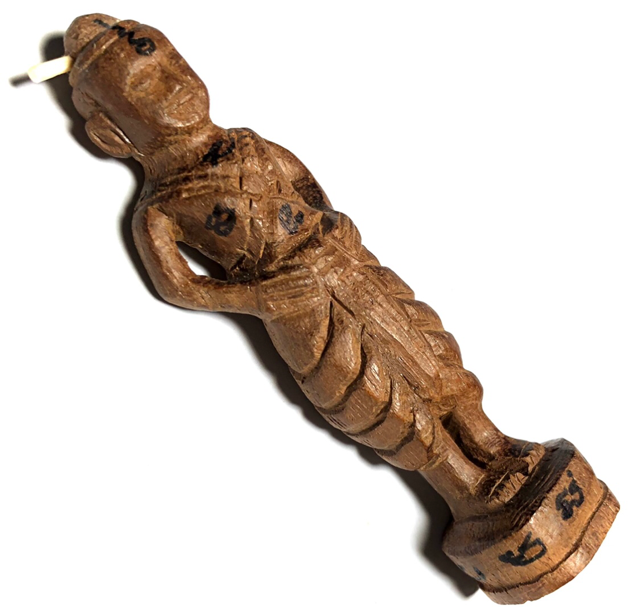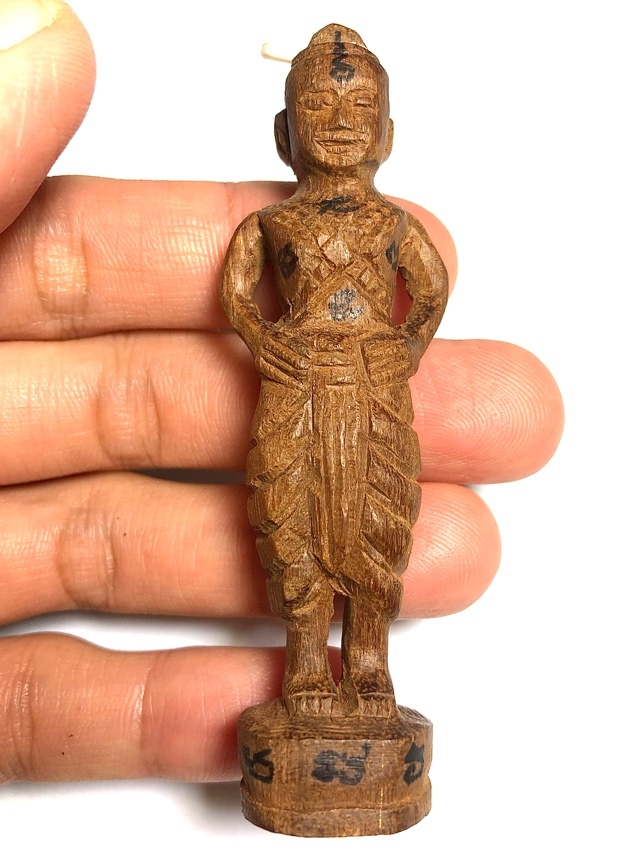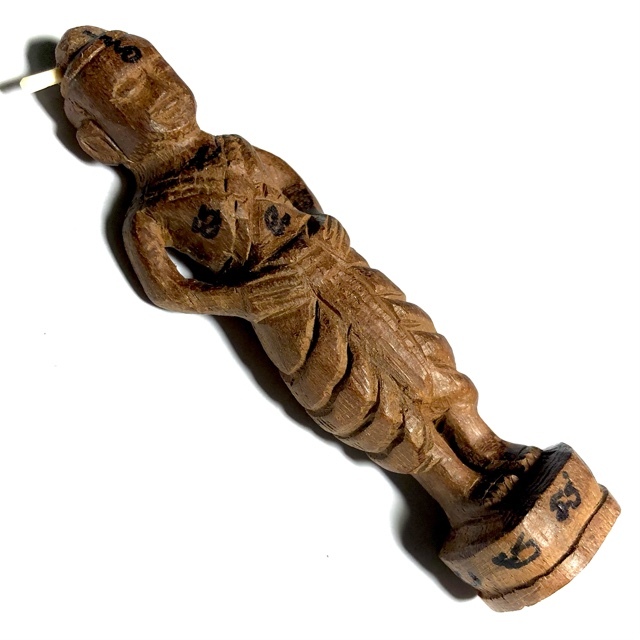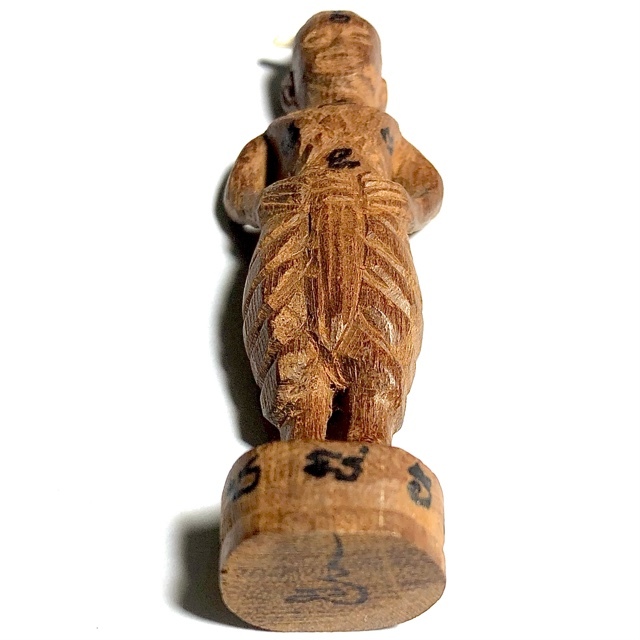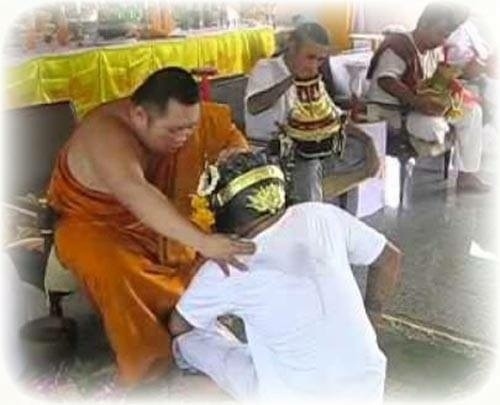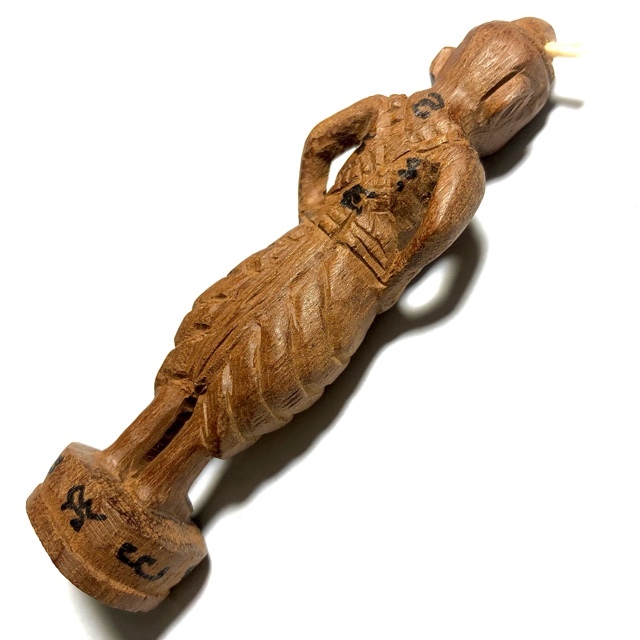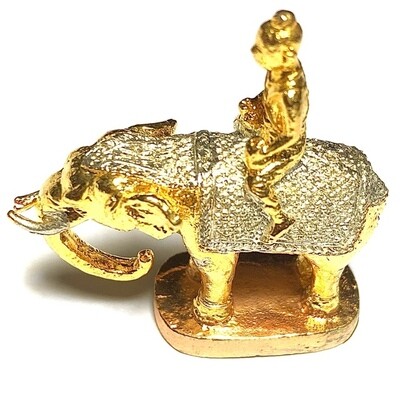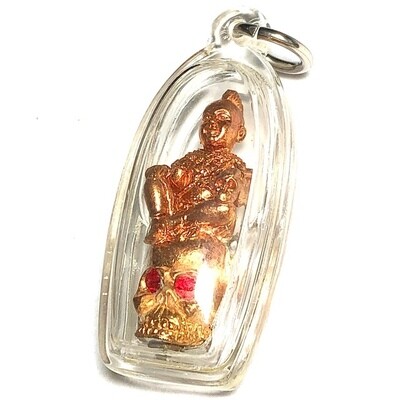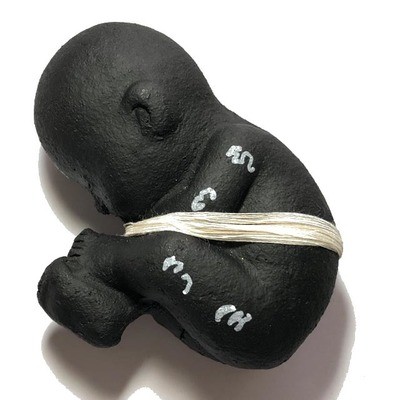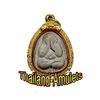

Thailand Amulets
Thai Buddhist and Magical amulets for Wealth, Health, Love and Happiness.
Vast Selection of Amulets
We have a vast selection of over 4000 different kinds of Sacred Amulets and Bucha Items, including Buddha Image, Loi Ongk statuettes, Buddhist Monk Coin Amulets, Takrut Charms, Nam Man Prai Oils, Mai Kroo Wands, Mitmor Ritual Knife, Lek Lai Kaya Siddhi Elemental Substance, Kumarn Tong, Gambling Amulets, Mae Nang Prai, Muan Sarn Sacred Powder Amulets, Palad Khik, Animist Charms, Necromantic Amulets, Buddhist, Animist, Brahman and Necromantic Amulets.
Kumarn Tong Mai Saksit Sacred Deva Inhabited Takian Wood Hand Spell Inscription Pra Ajarn Supasit Wat Bang Nam Chon
This rare Kumarn Tong statuette from Guru Master and Adept maker of high class fine quality powerful amulets, Pra Ajarn Supasit, is an absolute work of excellence in miniature. Carved by an experienced hand, using high artisanry fused with ancient Necromantic Sorcery, of the kind which is already, and is further destined to become ever more, a collectors' masterpiece and reference Objet D'art of the world of Buddhist Amulets.
One of a very small number of special, individually hand-carved, and empowered Kumarn Tong images, of a young Kumarn with topknot, and traditional Jong Graben trousers, as were worn in the times of Khun Chang Khun Phaen. Khun Chang Khun Phaen, is a Thai mythical work of classic literature, which is the source of the fame which the Wicha Kumarn Tong enjoys today. this particular form of Necromantic sorcery was not however, invented in this story. It existed for many hundreds, or perhaps thousands of years before that. But because the Wicha was used and spoken of in the story, this Wicha of Necromantic Invocation, is thus attributed to the story of Pra Khun Phaen. Pra Ajarn Supasit empowered a very small number of these extremely artistically, and well made hand carved effigies, in a very small number edition of perhaps a dozen or so carved images.
Its image and carving is slightly different in both size and detail for each piece of wood is of so, each individual effigy is in itself unique. The Kumarn Tong has recieved personal hand inscription of Ancient Khmer Necromantic Invocations of the 4 elements and the Kata Akarn 32 to imbue the effigy with a living spirit of the Kumarn. A piece of necromantic substance is inserted into the head of the Kumarn, with the Heart Mantra of Kumarn Tong embedded within it.
These are one of a very small number in a series of different Prai Deva, Kumarn Tong, Hun Payont, and Lersi hermit god images released by Pra Ajarn Supasit, made from various sacred alchemical metals, and sacred tree woods. The Amulets of this master are both rare and in high demand because he has never opted for the making of mass-produced Amulets. He has always preferred to produce small limited edition number of high quality sacred Amulets made from highly powerful sacred substances. Each individual carved wooden image differs slightly in color and appearance, as each was made and empowered one by one. This means that although a couple of dozen is already a miniscule number of amulets in this special edition, but that also, each amulet is unique in its own right.
For this reason, his Amulets increase in value at an incredible rate immediately after they disappear from the market places. They are highly prized both for their magical power, as well as for their speculative value and potential increase in that value as time passes. Their eventual sacred rarity is assured to increase steadily, as is their eventual high increase in value, which increases at a much faster rate than most Amulets of the present era.
Pra Ajarn Supasit is one of the true Adepts, who has mastered these techniques and his Kumarn Tong and Nang Prai, and Lersi Hermit God amulets, are considered to be amongst the most powerful of this era. The only other masters who are producing such powerful Kumarn Tong in the present era, are mostly Laymasters or Lersi, and of those, also not many of them in existence. As to ordained Buddhist monks, one could say that the only comparable masters to Pra Ajarn Supasit for making powerful Kumarn Tong and other similar necromantic amulets are Luang Por Dam of Wat Pra Puttabat, and Luang Por Kane, of Wat Koh Phu, who's are also becoming almost as legendary as the Kumarn Tong from the worlds most famous maker, the long deceased Luang Por Te of Wat Sam Ngam. We focus on trying to stock amulets from all three of these masters, for their true and great power and authentic magical amulets.
Few masters indeed can come close to the power of these three masters, who are three of our most preferred masters and most definitely our three most preferred masters for this particular kind of amulet. This is in our opinion, an absolutely pristinely made amulet of the finest quality, and the most auspicious blessings possible, especially when one considers the attributed meanings of the sacred white elephant, and what blessings it can bring. Pra Ajarn Supasit Is a master Gaeji Ajarn, Who is highly regarded, for his immensely high-quality and small limited editions of Sacred amulets, which are so highly prized for their rarity and sacred Muan Sarn ingredients, as well as for their incredible beauty, fine design and exquisiteness of form. Some masters and their amulets, become so preferred by small groups of essential rarity collectors, that all their amulets become immensely valuable.With Pra Ajarn Supasit, it is clear that his small limited series highly empowered and artistically fashioned amulets, are mostly preferred due into their rarity, reputed power, and beauty. Pra Ajarn Supasit is one of these masters, and is currently perhaps one of the most highly regarded and collected amulet makers on the high end higher price level collectors scene.
How to care for the Kuman Tong Deity, and which Kata to Chant;
Before you enter the house with the Kuman for the first time, light 36 incense sticks outside and pray to Mae Toranee (Mother Earth), Jao Tee and Jao Tang (the various local Deities, Devas and spirits), and other sacred presences in the household and family environment. Let your mind send a communication to the Kuman and let him know that you are inviting him to come and stay with you. Now you should also give a name to the Kuman Tong, one which you can easily remember at best.
Kata for giving the Name to the Kuman (chant when giving him his name).
“Naamaanang Samaa So Yudt Dta Tho Yudt Dta Tha” “In the Name of the Kroo Ba Ajarn – I name you (Name which you wish to give your Kuman Tong”.
Say this 3 times, and the next day chant only once. You must always remember his name and must introduce him to all people in the house, and ask him to also protect and lend prosperity to them all.
Kata Riak Kuman (Kata to call the Kuman Tong) - Chant to the Triple Gem first; ‘
Na Mo Dtassa Pakawadto Arahadto Sammaa Samputtassa
(3 times), then Chant the following Kata One time;
Gumaaro Waa Gumaaree Waa Aehi Jidt-Dtang Bpiyang Ma Ma Na Chaa Lee Dti Na Ma Pa Ta Aakajchaeuya Aakajchaahi Maani Maa Maa
Kumarn, or Kumara (Pali) means “young boy” (young girl would be “Kumaree”), Tong means golden. Kumarn Tong (alternatively spelled “Kuman Thong”), is not originally a Buddhist practice, rather pure “Saiyasart” (Occultism, in this case, Necromancy). It would also be accurate to class the practice of keeping Kuman Tong as an essentially Animist practice. The genuine Kumatn Tong which was revered and created in Ancient times according to traditional method, by Adept practitioners of Saiyasart, was made by surgically removing the unborn fetus of a child from the womb of its Mother. The body of the child would then be taken to a cemetery for the conduction of the Ceremony to invoke a Kumatn Tong. The body is roasted until dry whilst the Mage chants incantations of Magical Kata. In the case of making a female spirit child, the effigy is not called Kumarn Tong, rather “Hoeng Pray”.
Some Kuman effigies will be soaked in Nam Man Prai, which has extract of a dead child or a person who died in violent circumstances or an unnatural death. This is much less common now, due to the fact that this practice is now illegal if using fat from human babies for the consecrating oil. There are however still some authentically made amulets appearing. Some years ago a famous monk was thrown out of the Buddhist Sangha for roasting a baby. He was convicted, but later continued to make magic as a layperson after his release. The practice of creating Necromantic effigies of a Kumarn Tong comes from age old tradition in Siam. Thai folk have made Bucha to Animistic spirits and ghosts since time immemorial. The original Kumarn Tong came from children who died whilst still in their mothers womb. The Magic makers would take these stillborn babies and adopt them as their children. From what information has been gathered from ancient Thai manuscripts about how to make a Kumarn Tong, it appears that the correct method is to remove the dead baby surgically from the mothers womb, and take it to undergo the proper ceremonial ritual; The baby must be roasted until dry. This must be completed before dawn, and should be performed in a cemetery. Once the rite is completed, the dry roasted Kumarn should be painted with Ya Lak (a kind of lacquer used to cover amulets and Takrut with gold leaf), and covered in gold leaf. This is the real reason why this effigy received the name of “Kumarn Tong” (which means “Golden Baby Boy”).
Kumarn Tong in Modern times
As society developed and became “Civilized”, the practice of roasting dead babies became legally impossible to do, and so an adaptation of the making method was developed. One of the ways was to make a clay effigy using the earth from seven cemeteries, Mai Rak Soorn wood, or Mai Mayom wood was also used for making Kumarn Tong statues. Even iron is now used for the making of Kumarn Tong effigies. To invoke the magical power, the effigy is implanted with Kata to bring the Kumarn to life.
This is done by using Kata Taat See (invoking four elements), and Kata Agarn Sam Sip Sorng (32 parts of the Human body). It is believed, that this will cause the mind and spirit of a dead boy to arise within the effigy. Modern Kumarn effigies normally have curly hair, whereas the older style ones are bald, a should be the case with an unborn baby. The traditional methods state that a Kumarn must be treated like your own child. He must be offered food and drink, and even be called to come and eat every single time you are about to have the meal. It is believed that if the Kumarn is handled properly according to the correct ceremonies, he will then protect the house and its inhabitants from danger, and increase good business too.
How to Revere Kuman Tong
In Modern times, is has become common practice to offer “Nam Daeng” (a kind of red syrup drink), incense and flowers. This is of course done in moments of prayer or ceremony, but it should never be forgotten to call to come and eat when it is the meal time.
Kata Suad Bucha Kuman Tong (Dtugadtaa Tong)
Putassa Buchaa Tamassa Buchaa Sangkassa Buchaa
Badti Badti Buchaa Pawandtumae Ugaasa Ugaasa
“I beg to revere the Dtugadtaa Tong, that consciousness arises in the eyes, the mind, the body of the Kuman. Through all the merits I may have accumulated since endless lives uncountable, may all great fortunes and blessings come to me from all eight directions. May these blessings be bestowed on me through the Dtugadtaa Tong, who I shall pay offerings and respects to, and maintain with nourishment and caring affection each and every day. The word “Dtugadtaa means “Doll”.
How to Worship Kuman Tong (Traditional Method);
The first time you bring a Kuman to the home, you must first light 11 incense sticks, and ask the local Devas for permission to bring the Kuman into the Dwelling area.
Then use 5 incense stick to bring the Kuman into the house.
Light the 5 incense stick on the Buddha Bucha altar. Place the Kuman on a separate al;tar, or at least lower than the Buddhas or Monk images.
Kuman Tong Full Ceremonial Method
Chant and make offerings every morning and evening, and chant the Nippana Sutra for Prai 7 times each session (always chant Kata to the Triple Gem 3 times before any other Kata Chanting).
Kata for calling the Kuman Spirit to come and be your companion
Jijeruni Jidt-Dtang Jae Dta Sigang Ruubpang Nippaanang Dtang Nippudting Pa Ta Na Ma Dtaecho Taadtu Tikang Waa A Sa Ja Pa Waa Dto Saen Dto Aegachaanang Barang Yadtawaa Aakajchaahi
Kata for invoking the Kuman to come to life and do jobs for you
Jijeruni Jidt-Dtang Jae Dta Sigang Ruubpang Nippaanang Dtang Nippudting Ma Pa Ta Na Bpathawii Taadtu Tikang Waa Pa Ga Sa Ja Waa Dto Saen Dto Bpas Saa Hattayang Siwang Chiwang Udt-Dtaedti
Kata for fending off or chasing away Kuman or Prai spirits
Jijeruni Jidt-Dtang Jae Dta Sigang Ruubpang Nippaanang Dtang Nippudting Na Ma Pa Ta Aabpo Taadtu Tikang Waa Ja Pa Ga Sa Waa Dto Saen Dto As Saa So Nippaanang Suunyang Kajchadti
Kata for telling the Prai (Kuman Tong) to stay put in a place
Jijeruni Jidt-Dtang Jae Dta Sigang Ruubpang Nippaanang Dtang Nippudting Ta Na Ma Pa Waa Yo Taadtu Tikang Waa Sa Ja Pa Ga Waa Dto Saen Dto Puttaa Pantanaa Yagang Pan Tadt Dtawaa
Short Method
If you have little time and need a short way to do this, make offerings as usual with incense, rice whisky or fruits, savories and sweets, and use the following Kata for various purposes;
Heart Mantras of Nippanasut
Sa A Ni So (call to come to you)
So Sa A Ni (awaken and empower to send on missions)
Ni So Sa A (use to ward away spirits and ghosts)
A Ni So Sa (use to make the Kuman stay in one place)
See more Kata for Chanting to the Kumarn Tong Deity
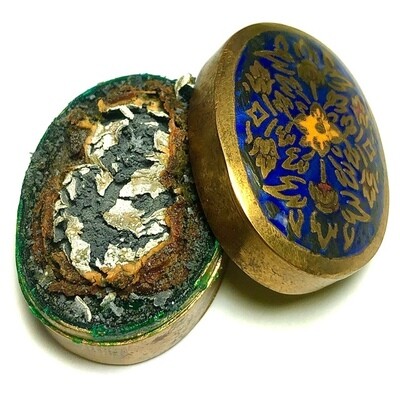
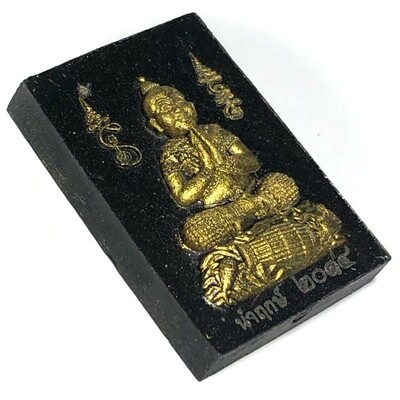
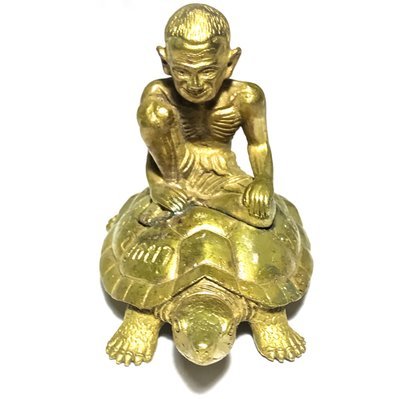
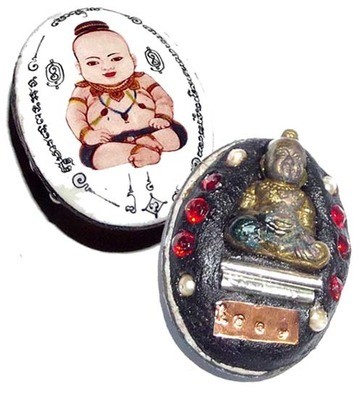
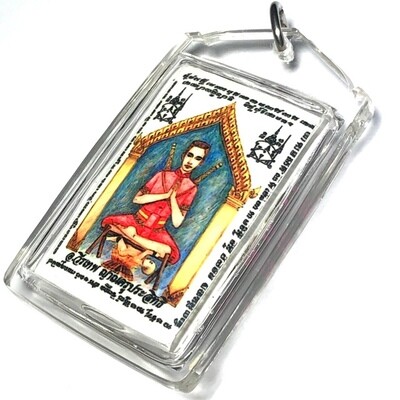
Contact Us
Follow Us on Youtube
About Us
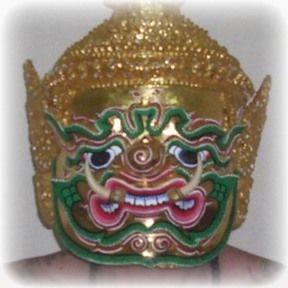
Ajarn Spencer
Proprietor
Thailand Amulets is owned and Administrated by Thai Occult and Amulet expert, Ajarn Spencer Littlewood who guarantees only authentic blessed amulets, and a free gift with every order, as well as his safe delivery or money back guarantee. https://facebook.com/ajarnspencer
